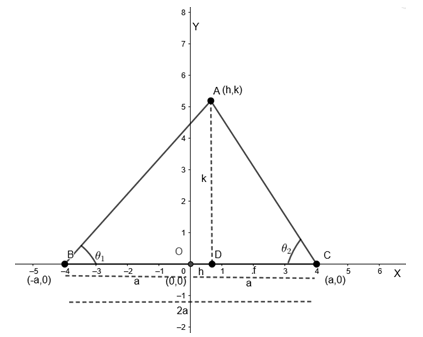
If a given base triangle is described such that the sum of the tangents of the base angles is constant, prove that the locus of the vertices is a parabola.
Answer
597.6k+ views
Hint: We need to take the given condition in co-ordinate plane and use \[\tan \theta =\dfrac{\text{perpendicular}}{\text{base}}\] in different triangles
Complete step-by-step answer:
Given that the sum of the tangents of base angles of the triangle is constant. We have to prove that the locus of the vertices is a parabola.

Let the given base of the triangle is BC of length 2a. Also let the coordinates of C be (a, 0) and B be (-a, 0) such that OB = OC = a.
We have to prove that the locus of A is parabola, so let the coordinates of A be (h, k).
Hence, we get OD = h and AD = k.
Also, given that the sum of tangents of angles B and C are constant.
Hence, we get \[\tan {{\theta }_{1}}+\tan {{\theta }_{2}}=C....\left( i \right)\left[ \text{C = constant} \right]\]
We know that \[\tan \theta =\dfrac{\text{perpendicular}}{\text{base}}\]
Therefore, \[\tan {{\theta }_{1}}=\dfrac{AD}{BD}=\dfrac{k}{a+h}\]
And \[\tan {{\theta }_{2}}=\dfrac{AD}{DC}=\dfrac{k}{a-h}\]
Now, we will put these values in equation (i).
We get \[\tan {{\theta }_{1}}+\tan {{\theta }_{2}}=C\]
\[\Rightarrow \dfrac{k}{a+h}+\dfrac{k}{a-h}=C\]
\[\Rightarrow \dfrac{k\left( a-h \right)+k\left( a+h \right)}{\left( a+h \right)\left( a-h \right)}=C\]
Cross Multiplying above equation, we know that,
\[\left( x+y \right)\left( x-y \right)={{x}^{2}}-{{y}^{2}}\]
We get, \[2ka=C\left( {{a}^{2}}-{{h}^{2}} \right)\]
By rearranging the equation, we get,
\[C{{h}^{2}}=C{{a}^{2}}-2ka\]
\[\Rightarrow {{h}^{2}}=\dfrac{-2a}{C}\left[ k-\dfrac{Ca}{2} \right]\]
Replacing h by x and k by y for the locus
\[\Rightarrow {{x}^{2}}=\dfrac{-2a}{C}\left[ y-\dfrac{Ca}{2} \right]\]
which is comparable to parabola.
\[{{\left( x-{{x}_{1}} \right)}^{2}}=-4a\left( y-{{y}_{1}} \right)\]
Hence, we proved that the locus of vertices is a parabola.
Note: Instead of taking arbitrary points, we must take the points in co-ordinate plane like we did in this question to make the question easily solvable. We must rearrange the equation until we get the desired form.
Complete step-by-step answer:
Given that the sum of the tangents of base angles of the triangle is constant. We have to prove that the locus of the vertices is a parabola.

Let the given base of the triangle is BC of length 2a. Also let the coordinates of C be (a, 0) and B be (-a, 0) such that OB = OC = a.
We have to prove that the locus of A is parabola, so let the coordinates of A be (h, k).
Hence, we get OD = h and AD = k.
Also, given that the sum of tangents of angles B and C are constant.
Hence, we get \[\tan {{\theta }_{1}}+\tan {{\theta }_{2}}=C....\left( i \right)\left[ \text{C = constant} \right]\]
We know that \[\tan \theta =\dfrac{\text{perpendicular}}{\text{base}}\]
Therefore, \[\tan {{\theta }_{1}}=\dfrac{AD}{BD}=\dfrac{k}{a+h}\]
And \[\tan {{\theta }_{2}}=\dfrac{AD}{DC}=\dfrac{k}{a-h}\]
Now, we will put these values in equation (i).
We get \[\tan {{\theta }_{1}}+\tan {{\theta }_{2}}=C\]
\[\Rightarrow \dfrac{k}{a+h}+\dfrac{k}{a-h}=C\]
\[\Rightarrow \dfrac{k\left( a-h \right)+k\left( a+h \right)}{\left( a+h \right)\left( a-h \right)}=C\]
Cross Multiplying above equation, we know that,
\[\left( x+y \right)\left( x-y \right)={{x}^{2}}-{{y}^{2}}\]
We get, \[2ka=C\left( {{a}^{2}}-{{h}^{2}} \right)\]
By rearranging the equation, we get,
\[C{{h}^{2}}=C{{a}^{2}}-2ka\]
\[\Rightarrow {{h}^{2}}=\dfrac{-2a}{C}\left[ k-\dfrac{Ca}{2} \right]\]
Replacing h by x and k by y for the locus
\[\Rightarrow {{x}^{2}}=\dfrac{-2a}{C}\left[ y-\dfrac{Ca}{2} \right]\]
which is comparable to parabola.
\[{{\left( x-{{x}_{1}} \right)}^{2}}=-4a\left( y-{{y}_{1}} \right)\]
Hence, we proved that the locus of vertices is a parabola.
Note: Instead of taking arbitrary points, we must take the points in co-ordinate plane like we did in this question to make the question easily solvable. We must rearrange the equation until we get the desired form.
Recently Updated Pages
Master Class 12 Business Studies: Engaging Questions & Answers for Success

Master Class 12 Economics: Engaging Questions & Answers for Success

Master Class 12 English: Engaging Questions & Answers for Success

Master Class 12 Maths: Engaging Questions & Answers for Success

Master Class 12 Social Science: Engaging Questions & Answers for Success

Master Class 12 Chemistry: Engaging Questions & Answers for Success

Trending doubts
What is meant by exothermic and endothermic reactions class 11 chemistry CBSE

Which animal has three hearts class 11 biology CBSE

10 examples of friction in our daily life

One Metric ton is equal to kg A 10000 B 1000 C 100 class 11 physics CBSE

1 Quintal is equal to a 110 kg b 10 kg c 100kg d 1000 class 11 physics CBSE

Difference Between Prokaryotic Cells and Eukaryotic Cells




